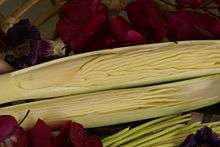Chamaedorea tepejilote
| Chamaedorea tepejilote Pacaya palm | |
|---|---|
 | |
| Pacaya palm (Chamaedorea tepejilote) taken at Atitlán Lake in Guatemala | |
| Scientific classification | |
| Kingdom: | Plantae |
| (unranked): | Angiosperms |
| (unranked): | Monocots |
| (unranked): | Commelinids |
| Order: | Arecales |
| Family: | Arecaceae |
| Genus: | Chamaedorea |
| Species: | C. tepejilote |
| Binomial name | |
| Chamaedorea tepejilote Liebm.[1] | |
Chamaedorea tepejilote, also known at the pacaya palm, is a species of Chamaedorea palm tree found in the understory of the forests of southern Mexico, Central America, and northern Colombia.[2]

The immature male inflorescences of the plant are considered a delicacy in Guatemala and El Salvador. The unopened infloresences resemble an ear of corn in appearance and size.[3] Indeed, the word tepejilote means "mountain maize" in the Nahuatl language and was selected because of this resemblance.[2] (Castillo Mont and his co-authors suggest that "pacaya," the common name for both the plant and its edible flower could be derived from the volcano of that name.[2])
Pacaya has a somewhat bitter taste, although less so in cultivated varieties.[2] It is eaten in salads (especially fiambre, a salad traditionally eaten in Guatemala on the Day of the Dead) or covered in egg batter and fried. The latter dish is called "rellenos de pacaya," and is often served with tomato sauce, like chiles rellenos.
References
- ↑ "Taxon: Chamaedorea tepejilote Liebm.". Germplasm Resources Information Network. United States Department of Agriculture. 1999-02-10. Retrieved 2013-08-27.
- 1 2 3 4 Castillo Mont, Juan José; Gallardo, Negli Rene; Johnson, Dennis V. (1994). "The Pacaya Palm (Chamadorea Tepejilote; Arecaceae) and its Food Use in Guatemala". Economic Botany. 48 (1): 69. doi:10.1007/bf02901383. Retrieved 29 August 2013.
- ↑ Cook, Orator Fuller (31 December 1910). "History of the Coconut Palm in America". Contributions from the United States National Herbarium. Bulletins of the United States National Museum. 14 (2): 311. Retrieved 29 August 2013.